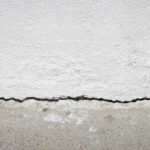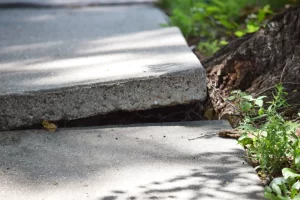
Recognizing water damage signs early is crucial to safeguarding your home from foundation cracks. Look out for musty odors, cracks in walls, peeling paint or wallpaper, mold and mildew growth, water stains, sagging floors, and increased water bills. Addressing these signs promptly can help prevent costly repairs in the future and maintain the structural integrity of your home. Understanding these warning signals can empower you to take proactive measures to protect your home from potential foundation issues.
Key Takeaways
- Watch for musty odors, mold, and mildew growth.
- Check for cracks, peeling paint, or water stains.
- Address sagging floors and increased water bills promptly.
- Hire a professional plumber for thorough inspections.
- Early leak detection prevents costly foundation damage.
Musty Odors
If you notice musty odors in your home, it could be an indication of water damage that may lead to foundation cracks. These odors often result from the presence of mold and mildew, which thrive in moist environments. To tackle this issue effectively, you must first identify the source of the excess moisture. Inspect areas prone to water leaks such as basements, crawl spaces, and bathrooms. Be sure to check for any signs of water stains on walls or ceilings, as these can point to hidden leaks.
Once you’ve located the source of the moisture, it’s essential to address it promptly to prevent further damage. Repair any leaks in pipes, roofs, or windows to eliminate the entry points for water. Consider using a dehumidifier to reduce humidity levels in your home, as this can help inhibit the growth of mold and mildew. Additionally, proper ventilation is key to promoting air circulation and preventing moisture buildup.
In cases where water damage is extensive, it may be necessary to seek professional help for remediation. Mold remediation experts can assess the extent of the damage, remove any mold growth, and restore your home to a safe condition. By addressing musty odors promptly and addressing the underlying water damage, you can help prevent the development of foundation cracks and maintain a healthy living environment for you and your family.
Cracks in Walls
Musty odors in your home could be an early warning sign of water damage that may eventually lead to cracks in your walls. If left unchecked, water seepage can weaken the structure of your walls, causing cracks to form over time.
Here are three key signs to look out for:
- Visible Cracks: Keep an eye out for cracks on your walls, especially near areas where water pipes run or close to the ceiling. These cracks may start small but can widen over time as water damage progresses.
- Bulging or Bowed Walls: Water infiltration can cause walls to swell or bow outwards. This distortion is a clear indication of underlying water damage that could potentially lead to cracks if not addressed promptly.
- Dampness or Discoloration: Touch the walls to check for any dampness or moisture present. Additionally, look for any areas where the paint is discolored or peeling off, as this could be a sign of water damage affecting the integrity of your walls.
Peeling Paint or Wallpaper
Peeling paint or wallpaper can indicate underlying water damage that may compromise the integrity of your walls. When you notice paint or wallpaper peeling off in certain areas of your home, it’s essential to investigate the root cause promptly. Water infiltration behind walls can lead to the separation of paint or wallpaper from the surface. This peeling occurs because water weakens the adhesive properties of the paint or wallpaper, causing them to detach from the wall.
To address peeling paint or wallpaper effectively, you should first identify the source of the water intrusion. Common culprits include leaky pipes, roof leaks, or poor exterior drainage directing water towards your house. Once you pinpoint the source, it’s vital to fix the issue promptly to prevent further water damage. Ignoring peeling paint or wallpaper can result in more severe problems such as mold growth or structural damage to your walls.
In addition to compromising your walls’ structural integrity, peeling paint or wallpaper can also negatively impact your home’s aesthetics. It can make rooms appear unkempt and reduce the overall appeal of your living space. By addressing peeling paint or wallpaper promptly, you can prevent further damage and maintain a visually pleasing environment in your home.
Mold and Mildew Growth
You can easily spot mold and mildew growth in your home by inspecting damp and poorly ventilated areas such as basements and bathrooms. These fungi thrive in moist environments and can be a clear indicator of water damage issues that may lead to foundation cracks.
Here are three signs to look out for:
- Vital Odor: When mold and mildew start growing in hidden corners or behind walls, they release a distinct musty smell. If you notice an unpleasant odor that doesn’t seem to go away, it could be a sign of hidden mold growth.
- Visible Spots: Mold and mildew often appear as dark spots or patches on walls, ceilings, or even on furniture. Check for any discoloration or fuzzy growth in areas prone to moisture accumulation.
- Health Symptoms: Exposure to mold spores can cause various health issues such as allergies, respiratory problems, or skin irritation. If you or your family members experience unexplained health symptoms like coughing, sneezing, or itchy eyes when at home, it could be due to mold presence.
Regularly inspecting your home for mold and mildew growth is paramount in preventing water damage that can ultimately affect the foundation of your house. If you notice any of these signs, addressing the underlying moisture issue promptly is necessary to avoid further damage.
Water Stains
Inspecting water stains in your home is an essential step in identifying potential water damage issues that can impact your foundation. Water stains on walls or ceilings are often indicative of leaks from plumbing, roofs, or windows. These stains may appear as discolored patches, peeling paint, or bubbling wallpaper. It’s important to address these stains promptly to prevent further water infiltration that could lead to foundation problems.
When you notice water stains, start by determining the source of the leak. Check for any plumbing issues such as leaking pipes or fixtures. Inspect the roof for missing shingles, damaged flashing, or clogged gutters that may be causing water to seep into your home. Additionally, examine window seals for gaps or cracks that could be allowing water to enter.
Ignoring water stains can result in more severe water damage, compromising the structural integrity of your home’s foundation. As water continues to infiltrate your home, it can weaken the foundation, leading to cracks and settlement issues. Addressing water stains promptly not only protects your foundation but also helps maintain a healthy indoor environment by preventing mold growth and structural deterioration.
Sagging Floors
Addressing sagging floors promptly is essential in preventing further structural damage to your home’s foundation. When you notice your floors starting to dip or slope, it could be a sign of underlying issues that need immediate attention. Here are some key indicators to help you identify and address sagging floors effectively:
- Unevenness: Walk around your home and pay attention to any areas where the floor feels uneven or slopes downwards. This unevenness can indicate that the foundation underneath is shifting, causing the floors to sag.
- Visible Gaps: Look for gaps between the floor and the baseboards or walls. These gaps can be a clear sign that the floors are sagging and may be pulling away from the rest of the structure.
- Bouncing or Squeaking: If you notice that your floors bounce or squeak when you walk on them, it could be a result of sagging. The bouncing indicates that the floor joists aren’t properly supporting the weight, leading to sagging and potential structural issues.
Increased Water Bills
Noticing a notable increase in your monthly water bills can serve as an early warning sign of potential water-related issues that may impact your home’s foundation. If your water bills have been steadily increasing without a corresponding change in usage habits, it could indicate a hidden leak within your plumbing system. Undetected leaks can lead to excess moisture around your home’s foundation, causing soil erosion and potential structural damage over time.
To investigate the source of the increased water bills, start by checking for visible signs of water leaks such as damp spots, water stains, or mold growth in your basement or crawl spaces. Inspect your faucets, toilets, and water-using appliances for any signs of leaks or drips. A running toilet or a dripping faucet may seem minor, but over time, they can significantly contribute to inflated water bills and potential foundation issues.
Consider hiring a professional plumber to conduct a thorough inspection of your plumbing system if you suspect a hidden leak. Advanced techniques such as thermal imaging or pressure testing can help identify leaks that aren’t easily visible. Addressing water leaks promptly not only helps lower your water bills but also mitigates the risk of water damage to your home’s foundation, ultimately preventing costly repairs in the future.
Frequently Asked Questions
How Can I Determine if the Water Damage Is Coming From a Plumbing Issue Rather Than External Sources?
To determine if water damage stems from plumbing problems or outside sources, inspect for leaks, check water pressure, and monitor utility bills for spikes. If issues persist, consult a plumber for professional assessment and repairs.
Are There Any Specific Areas of the Foundation That Are More Prone to Cracking Due to Water Damage?
When it comes to foundation cracks from water damage, certain areas like corners and around windows are more vulnerable. Regularly check these spots for signs of water intrusion to catch issues early.
What Steps Can I Take to Prevent Water Damage in My Basement or Crawl Space?
To prevent water damage in your basement or crawl space, start by sealing any cracks, installing proper drainage systems, ensuring proper grading, and maintaining gutters. Regularly inspect for leaks and address them promptly to avoid costly repairs.
How Long Does It Typically Take for Water Damage to Lead to Foundation Cracks if Left Untreated?
If you ignore water damage, it can lead to foundation cracks over time. Typically, the duration varies based on the severity of the issue. Address water damage promptly to prevent structural problems and costly repairs.
Are There Any Warning Signs of Water Damage That May Not Be Immediately Visible to the Naked Eye?
You might not notice all water damage warning signs at first. Look for musty smells, peeling paint, or warped walls. Addressing hidden water issues early can prevent costly foundation cracks in the future.
Conclusion
Lifetime Basement Waterproofing has been Atlanta’s premier basement waterproofing company for over 30 years. We’re a family-owned and operated company that specializes in basement waterproofing.
Our team provides many other services at an expert level. These include crawlspace encapsulation, exterior foundation waterproofing, foundation crack repair, and drainage strategy for French drains. You can count on Lifetime Basement Waterproofing for your wet basement repair needs.
By recognizing the signs of water damage in your home, you can prevent costly foundation cracks. Keep an eye out for musty odors, cracks in walls, peeling paint or wallpaper, mold and mildew growth, water stains, sagging floors, and increased water bills.
Addressing these issues promptly can save you time and money in the long run. Don’t ignore the warning signs – take action to protect your home’s foundation and contact us today for a free estimate.






No comment yet, add your voice below!